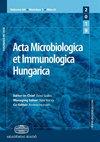Prevalence and genetic characteristics of Staphylococcus aureus isolates from cell phones of medical students from Iran.
IF 1.6
4区 医学
Q4 IMMUNOLOGY
引用次数: 0
Abstract
Although mobile phones as a rapid communication vehicle can lead to improved quality of healthcare, they can also facilitate the transmission of pathogens to patients. This current research focuses on genetic diversity, and genes involved in resistance and biofilm production of Staphylococcus aureus isolates from mobile phones of medical students. Antibiotic resistance profiling and polymerase chain reaction (PCR) amplification of antibiotic resistance and biofilm-related genes were investigated and statistically analyzed. Staphylococcal cassette chromosome mec (SCCmec) types were analyzed by multiplex PCR, and S. aureus protein A gene typing (spa typing) was done using PCR and sequencing. Sixty-four S. aureus isolates (16.8%) were obtained from 380 medical students' mobile phones who were working in hospitals. The findings showed that 71.9% of the isolates were MRSA and 78.1% were classified as MDR. All isolates exhibited sensitivity to vancomycin and linezolid. Overall, 7.8% of the isolates displayed an inducible clindamycin resistance phenotype, while 26.7% showed resistance to mupirocin. The results indicated that 68.8% of the isolates were biofilm producers, with 7 isolates (15.9%) classified as strong producers, 22 isolates (50%) as moderate producers, and 15 isolates (34.1%) as weak producers. The most prevalent type was CC8-MRSA III/t030 (18.7%), followed by CC8-MRSA III/t037 (12.5%), CC/ST22-MSSA/t790 (10.9%), CC1-MRSA IV-t114 (9.4%), CC1-MRSA IV-t127 (7.8%), CC8-MRSA V/t064 (7.8%), CC/ST15-MSSA-t360 (7.8%), CC30-MSSA/t021(6.3%), MRSA V-t355 (6.3%), CC8-MRSA III/t421 (4.7%), CC1-MRSA V-t267 (4.7%), and CC/ST15-MSSA-t084 (3.1%). The genetic diversity and prevalent multidrug resistance indicate that the resistance situation of S. aureus recovered from mobile phones in Tehran is severe, posing a potential threat to patients, the community, and healthcare settings.从伊朗医学生手机中分离出的金黄色葡萄球菌的流行率和遗传特征。
虽然手机作为一种快速通信工具可以提高医疗质量,但也会促进病原体传播给病人。目前的研究重点是医学生手机中分离出的金黄色葡萄球菌的遗传多样性、耐药性基因和生物膜产生。研究人员对抗生素耐药性分析和聚合酶链反应(PCR)扩增抗生素耐药性和生物膜相关基因进行了调查和统计分析。通过多重聚合酶链反应分析了金黄色葡萄球菌盒式染色体mec(SCCmec)类型,并通过聚合酶链反应和测序进行了金黄色葡萄球菌蛋白A基因分型(spa分型)。从 380 名在医院工作的医学生的手机中获得了 64 个金黄色葡萄球菌分离物(16.8%)。研究结果显示,71.9%的分离株为 MRSA,78.1%被归类为 MDR。所有分离菌株均对万古霉素和利奈唑胺敏感。总体而言,7.8%的分离株显示出诱导性克林霉素耐药表型,26.7%显示出对莫匹罗星耐药。结果表明,68.8%的分离株是生物膜生产者,其中 7 个分离株(15.9%)为强生产者,22 个分离株(50%)为中等生产者,15 个分离株(34.1%)为弱生产者。最常见的类型是 CC8-MRSA III/t030(18.7%),其次是 CC8-MRSA III/t037(12.5%)、CC/ST22-MSSA/t790(10.9%)、CC1-MRSA IV-t114(9.4%)、CC1-MRSA IV-t127(7.8%)、CC8-MRSA V/t064(7.8%)、CC/ST15-MSSA-t360(7.8%)、CC30-MSSA/t021(6.3%)、MRSA V-t355(6.3%)、CC8-MRSA III/t421(4.7%)、CC1-MRSA V-t267(4.7%)和CC/ST15-MSSA-t084(3.1%)。遗传多样性和普遍的多药耐药性表明,德黑兰手机中发现的金黄色葡萄球菌耐药性情况严重,对患者、社区和医疗机构构成了潜在威胁。
本文章由计算机程序翻译,如有差异,请以英文原文为准。
求助全文
约1分钟内获得全文
求助全文
来源期刊

Acta microbiologica et immunologica Hungarica
IMMUNOLOGY-MICROBIOLOGY
CiteScore
2.30
自引率
13.30%
发文量
36
审稿时长
>12 weeks
期刊介绍:
AMIH is devoted to the publication of research in all fields of medical microbiology (bacteriology, virology, parasitology, mycology); immunology of infectious diseases and study of the microbiome related to human diseases.
 求助内容:
求助内容: 应助结果提醒方式:
应助结果提醒方式:


